| Skip Navigation Links | |
| Exit Print View | |

|
Oracle Java CAPS Database Binding Component Tutorial Java CAPS Documentation |
| Skip Navigation Links | |
| Exit Print View | |

|
Oracle Java CAPS Database Binding Component Tutorial Java CAPS Documentation |
Using the Database Binding Component
Database Binding Component Project in a Nutshell
Starting the GlassFish V2 Application Server
To Start the GlassFish V2 Application Server From NetBeans IDE
Creating a BPEL Module Project For Table Type Operations
To Create a BPEL Module Project
Connecting to a MySQL Database
To Connect to a MySQL Database
Starting the GlassFish Admin Console
Creating a JDBC Connection Pool
To Create a JDBC Connection Pool
Creating a WSDL Document For Type : DATABASE
To Create a WSDL Document : dbWSDL
To Select the Database Connection
Creating a WSDL Document For Type SOAP
To Create a WSDL Document : SOAPWSDL
To Add a Web Service and Basic Activities
To Edit Web Service : Receive1
To Edit the Web Service : Invoke1
To Edit the Web Service : Reply1
Creating the Composite Application Project
To Create the Composite Application Project
Deploying and Testing the Composite Application
To Deploy the Composite Application
To Test the Composite Application
Creating a BPEL Module Process Using Prepared Statements
In this section, you add a BPEL process file, for example, BPELProcess.bpel. Add a partner link and three activities to the BPEL process file.
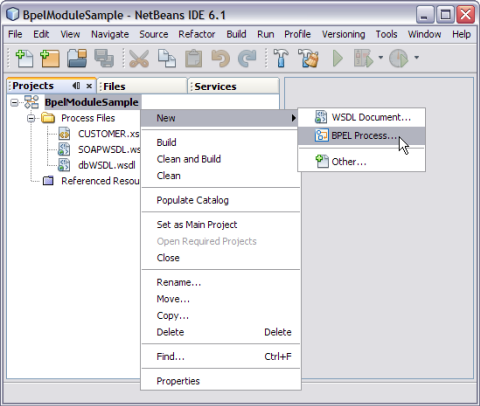
This opens the New BPEL Process wizard.
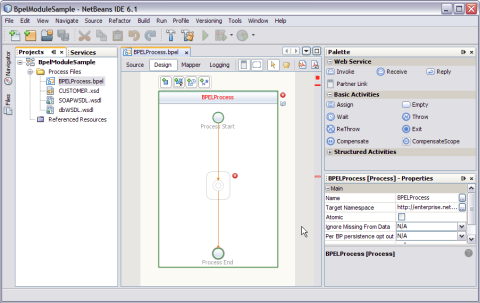
Note -
In the Projects window, the IDE adds a BPELProcess.bpel node under the Process Files node.
The BPELProcess.bpel file is open in the BPEL Designer.
The Properties window is open.
If you do not see the Properties window, choose Window —> Properties.
The Navigator window is open showing the BPEL Logical View of the BPEL Process document.
This is the Input WSDL.

This is the Output WSDL.
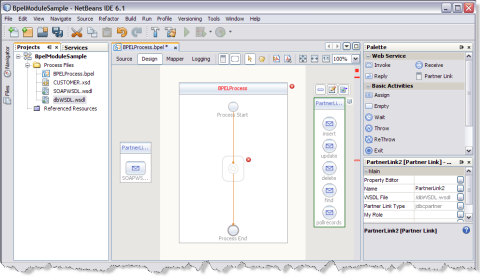
Drag and Drop the following Web Services:
Receive
Invoke
Reply
Drag and Drop the Basic Activities : Assign1 and Assign2.
The IDE provides the visual clues to show an appropriate location to drop the selection.

This action places a Web Service Receive called Receive1 in the Design view.
This action places a Assign activity called Assign1 in the Design view.
Note - Repeat steps 1 through 4 to select Invoke1, Assign2, and Reply1.
Choose the following:
Select the Web Service : Invoke and Basic Activities : Assign.
Select the Web Service ; Reply.

Note - In the diagram, a red cross next to an element means that the element has not passed validation and the output contains errors. Edit each Sequence to pass validation.
The icon symbolizes that the Web Services can be edited.
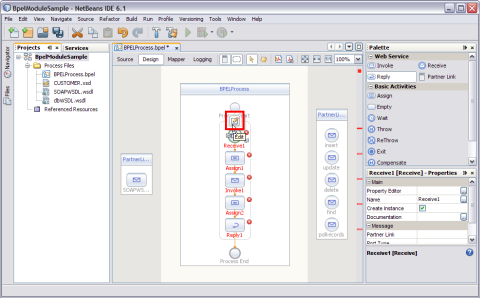
This opens the Receive1 [Receive] - Property Editor.
The IDE fills in the Operation field with SOAPWSDLOperation.

Perform the following:
Click the Create button next to the Input Variable field.
This opens the New Input Variable dialog box.
The Name, Type, and Scope are displayed, by default.
You can also change the value in the Name field.
Click OK.
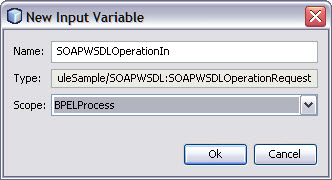
Note - All the fields are populated with the assigned values.
Input Variable — SOAPWSDLOperationIn
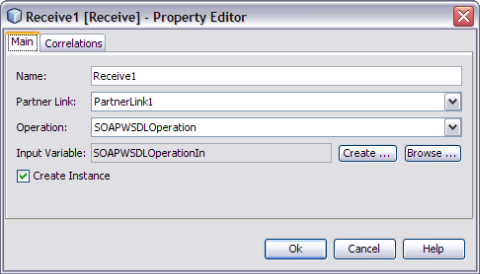
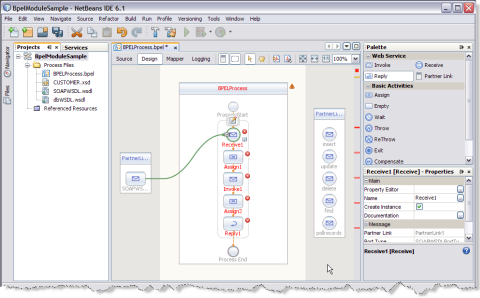
This opens the Invoke1 [Invoke] - Property Editor.
Select any one of the Operations from the drop-down list.
Insert
Update
Delete
Find
Pollrecords
Select Operation — find from the drop-down list. The IDE fills in the Operation field.
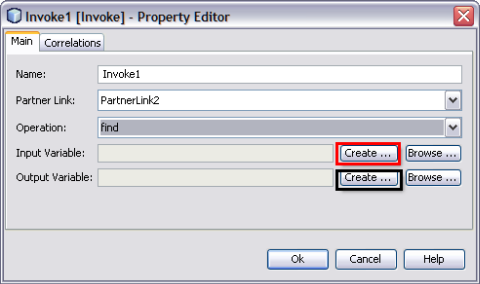
This opens the New Input Variable dialog box.

The Name, Type, and Scope are displayed, by default.
You can also change the value in the Name field.
This opens the New Output Variable dialog box.
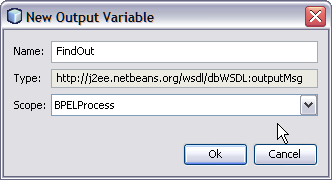
The Name, Type, and Scope are displayed, by default.
You can also change the value in the Name field.
Note - All the fields are populated with the assigned values.
Select the following Variables:
Input Variable : FindIn
Output Variable : FindOut
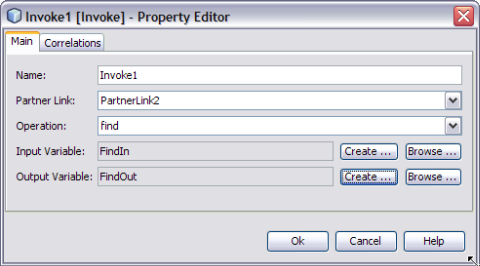
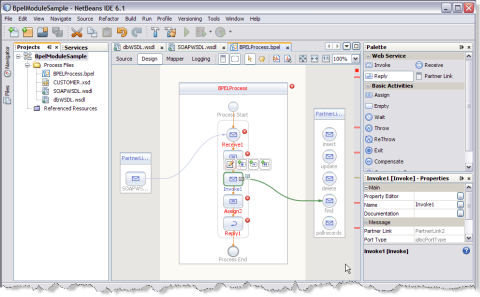
This opens the Reply1 [Reply] - Property Editor.
The IDE fills in the Operation field with SOAPWSDLOperation.
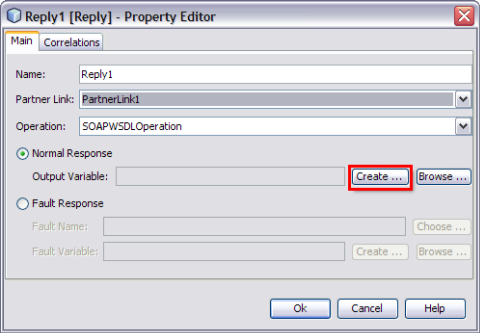
This opens the New Output Variable dialog box.
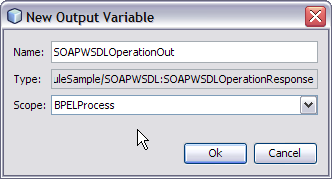
Reply1 is displayed, by default.

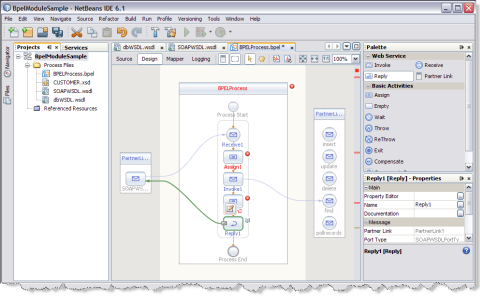
This displays the BPEL Mapper window.
A part1 node appears under the SOAPWSDLOperationIn node.
A part node appears under the FindIn node.
For example, SOAPWSDLOperationIn — part1 — CUSTOMER_Record.
For example, FindIn — part — CUSTOMER_Record.
Map the following Variables:

Note - A red icon marked against Basic Activities — Assign1 is not shown.

This displays the BPEL Mapper window.
For example, FindOut : part : CUSTOMER_Record.
For example, SOAPWSDLOpertionOut : part1 : CUSTOMER_Record
Map the following variables:
PHONE : PHONE
STATE : STATE
NAME : NAME
ZIP : ZIP
ADDRESSLINE1 — ADDRESSLINE1
ADDRESSLINE2 — ADDRESSLINE2
CREDIT_LIMIT — CREDIT_LIMIT
EMAIL — EMAIL
CUSTOMER_ID — CUSTOMER_ID
CITY — CITY
FAX — FAX
DISCOUNT_CODE — DISCOUNT_CODE
Finally, map part : part1.
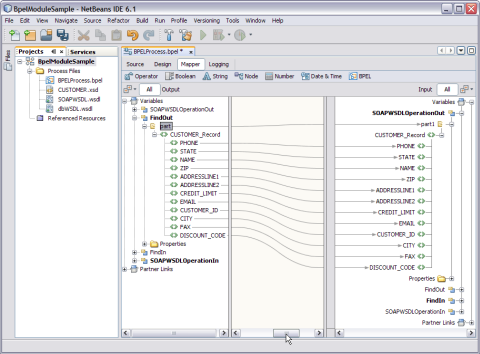
The final output is as shown in the illustration.
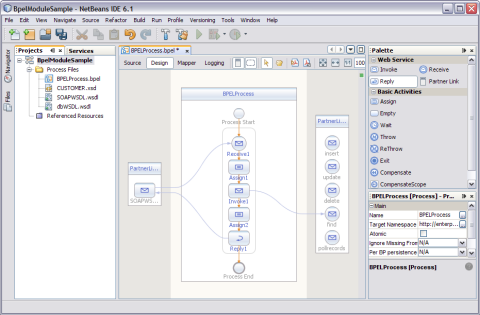
The following message is displayed.
BUILD SUCCESSFUL (total time: 2 seconds).